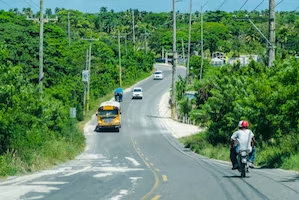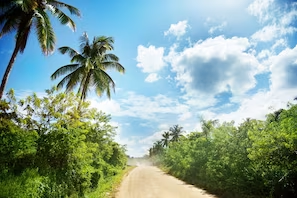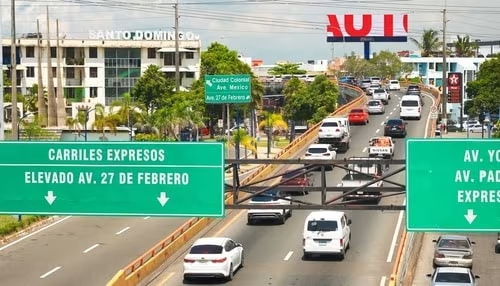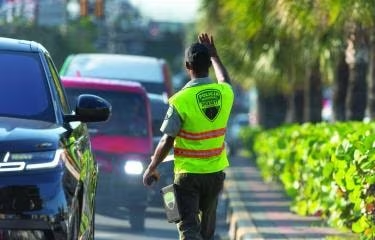Map of Dominican Republic
Driving in Dominican Republic
Driving in the Dominican Republic. Dream beaches, green mountains and... crazy roads. Driving in the Dominican Republic can be intimidating but with a little prep and some tips you’ll be cruising like a local in no time. We give you all the tips you need to make your driving experience stress free.
Get ready to live this country to the fullest, whether you’re in Santo Domingo or Punta Cana. Get ready to book or rent a car as soon as you arrive and start discovering the Dominican Republic.

Basic driving in the Dominican Republic
1. Highway Code
Let’s start with the basics of the highway code. In theory the rules of the road are similar to ours. In practice... let’s say they are more “flexible”.

Traffic direction: Right hand side.
Speed limits: In town 40 km/h, on national roads 80-100 km/h. Don’t forget the signs, even if they are few and far between.
Seat belts: Mandatory for all passengers. Yes, even for those who like to live life on the edge in the back seat.
2. Road conditions
The roads in the Dominican Republic are a mix of everything. You’ll find modern highways, scenic country roads and sometimes dirt roads that will make you feel like Indiana Jones. Renting a car is ideal.

Highways: Generally good condition, but watch out for motorbikes and pedestrians.
Secondary roads: Potholes and sharp curves.
Signage: Sometimes non-existent or confusing. Always have a GPS or offline map handy.
Tips to make your driving in the Dominican Republic stress free

1. Be aware
Unfortunately traffic accidents are common. Here are some tips to avoid them:
Defensive driving: anticipate what other drivers will do and be ready to react.
Keep your distance: always keep a safe distance, even if the locals seem to ignore it. In the Dominican Republic cars don’t always pass technical inspection and the road network is not always free of surprises.
2. Prepare for chaos
Stay Alert with the traffic lights
Dominicans have a very creative approach to driving. Red lights? Just a suggestion. Blinkers? Why bother? But with a little patience and a good dose of awareness you’ll get used to them.
Look around: never assume other drivers obey the rules.
Use the horn: the horn is a essential tool of communication. A little “beep” to greet, warn or show your frustration.

3. Night driving
Night driving can be even more fun. Roads are often poorly lit and animals love to wander.
Turn on the headlights: It’s obvious but some people forget.
Double alert: watch out for pedestrians and unlit motorbikes.
Public transportation
If you don’t want to drive, public transportation is an option:
Taxis and motoconchos: You’ll find a motor anywhere but always negotiate the fare before getting in.
Guaguas: Local minibuses, good for short and cheap trips but often overcrowded.

Road hazards
Driving in the Dominican Republic is not without risks. Be aware of the most common hazards to stay safe and safe for others:
Motorcycles and motoconchos: You’ll see motorcycles and motoconchos between cars, often without respecting the traffic rules. Watch out for their crazy movements.
Animals on the road: Especially in rural areas you’ll see dogs, cows and horses crossing the road. Drive at a moderate speed and always be aware.
Weather conditions: Rain can make the roads very slippery and potholes can fill with water, hiding their depth. Drive careful during and after rain.
Tolls in major cities of the Dominican Republic

In the Dominican Republic many highways have tolls. Here are some key points to keep in mind:
Toll locations: You’ll find toll booths on highways like Autopista Las Americas, Autopista Duarte and Autopista del Coral. Have cash on hand as credit cards are not always accepted.
Cost: Rates vary depending on the road and the vehicle. For standard cars the cost is usually between 60 to 100 Dominican pesos.
Tip: Keep the exact change to speed up the process and avoid any problems. Also respect the lines and signs at the toll booths.
Traffic accidents in the Dominican Republic

Traffic accidents are a big problem in the Dominican Republic, for locals and tourists. Many factors contribute to the high accident rate: driving the wrong way, using the mobile while driving and not taking measures to prevent vehicle and belongings theft. Knowing these will help you to stay safe on the road.
One of the main causes of traffic accidents in the Dominican Republic is not respecting the traffic rules. You’ll see drivers going the wrong way on one way streets, which can be very dangerous. Also using the mobile while driving is very common, which increases the risk of accidents. To stay safe always respect the traffic signs and avoid distractions like mobiles while driving.
People in the Dominican Republic speak Spanish so it’s good to learn some basic phrases to communicate, especially in case of an emergency. In case of an accident being able to explain the situation and understand the instructions of the local authorities can be key. Also to prevent theft always lock your vehicle, don’t leave valuables in plain sight and park in secure, well lit areas. By taking these precautions you’ll reduce the risk of traffic accidents and theft and have a safer and more enjoyable driving experience in the Dominican Republic.
Renting a car in the Dominican Republic is a great way to see the country at your own pace and visit places not accessible by public transportation. There are many car rental companies but one of the most recommended is JumboCar. They have a wide range of vehicles from economy to SUV to suit any type of travel and need.
JumboCar has offices in the main airports and cities of the country so it’s very easy to pick up and return the car. You can find them at airports like Santo Domingo. Booking in advance through their website not only guarantees the availability of the vehicle you want but also gives you better rates and promotions.
Also JumboCar stands out for its customer service and for offering insurance options to give you peace of mind during your trip. Be sure to read the rental conditions and ask any questions you may have before signing the contract. It’s also a good idea to inspect the car before leaving the pick up location to avoid extra charges for existing damage. With these precautions renting a car in the Dominican Republic can be a smooth and safe experience and you can enjoy your adventure in this lovely country.
Beware of police or Amet bites! Respect the local traffic laws
Driving in the Dominican Republic can be an adventure but it also comes with some challenges. One of the biggest problems for drivers, locals and tourists alike, is to encounter police or Amet agents asking for “mordidas” or bribes. Be prepared and know how to handle these situations to avoid complications.

First you must always carry with you all the necessary documents: driver’s license, passport or ID and vehicle papers. When stopped by a traffic officer stay calm and be polite. Ask him what’s the reason for the stop and show the requested documents. Remember that although it’s common for some officers to ask for bribes it’s not legal or acceptable.
To avoid these situations altogether respect the traffic rules especially the speed limits. Common infractions like speeding will attract the attention of the officers. Always keep your speed within the limits: 40 km/h in urban areas and 80-100 km/h on national roads. Also make sure all passengers wear seat belts and don’t use your cell phone while driving. Following these rules will not only help you avoid fines and bribes but also will keep you and your passengers safe.
Is it safe to drive in the Dominican Republic?
Yes, there’s no problem driving here but always be aware and ready to react to other drivers’ crazy behavior.
Do I need an international driver’s license or permit?
Your national driver’s license is enough for short stays. For longer stays an international driver’s license is recommended.
Are the roads well signposted?
Road signs may be missing or confusing in some areas. A GPS or navigation app is highly recommended.
What are the main hazards on the road?
Besides crazy drivers, watch out for potholes, animals and motorcycles without lights at night.
Are gas stations easy to find?
Yes, gas stations are plenty, especially in tourist areas and big cities. Fill up before heading to more remote areas.
Driving in the Dominican Republic can be an adventure, for the beautiful scenery and the little surprises on the road. Now you are ready to get behind the wheel and enjoy this beautiful country. Renting a car is easy so don’t wait and drive!